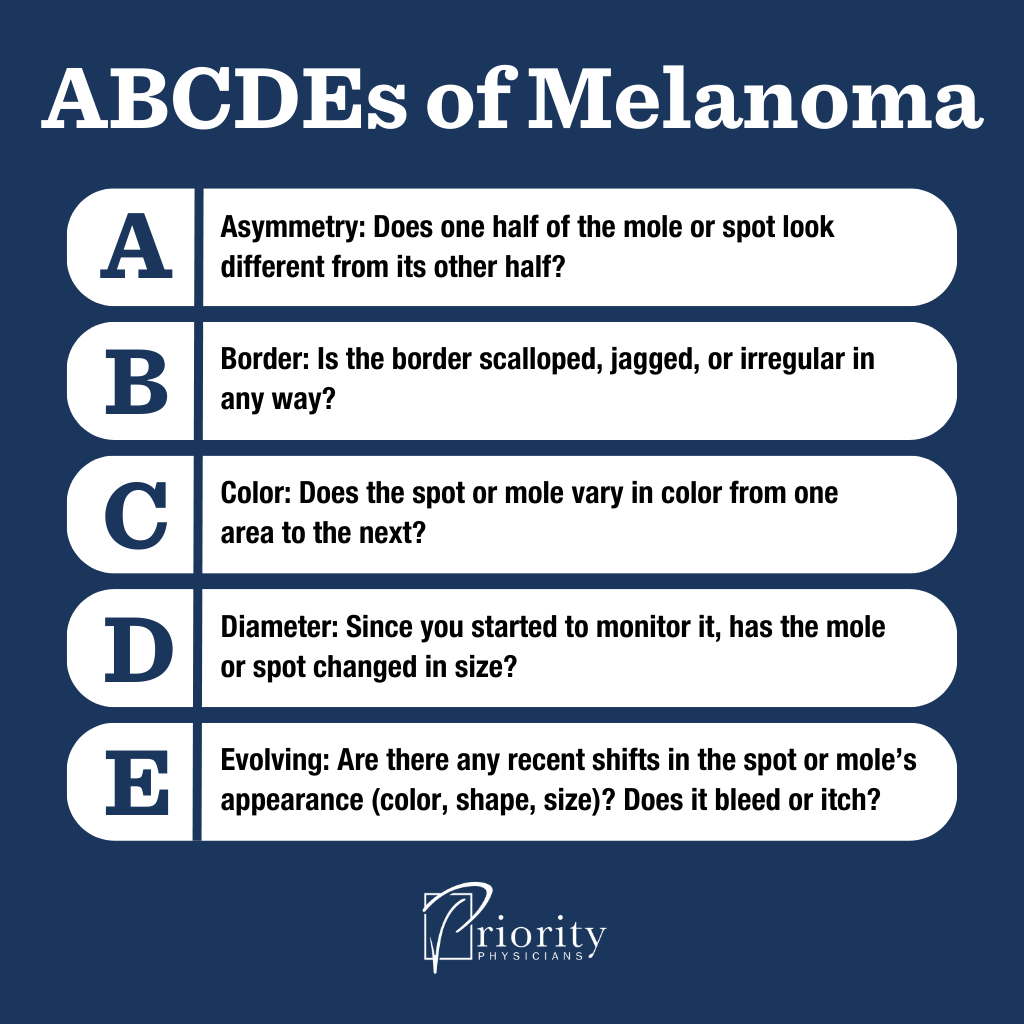It’s summertime and, for many people, the race is on to achieve a bronzed, sun-kissed look.
Not too long ago, masses of dedicated tanners rubbed baby oil on their skin before lounging in the sun. Bad idea. That slick layer of oil points ultraviolet rays (UVA and UVB) directly into the skin, intensifying sun damage.
Today, as we’ve gotten smarter about the dangers of skin cancer, it’s never been more important to protect the skin from destructive UV rays. Enjoying the outdoors with unprotected skin increases your risk of burns, early aging, and the three main skin cancers: basal cell carcinoma, squamous cell carcinoma, and melanoma.
In fact, over 90% of skin cancers are caused by UV damage, and one in five Americans will develop some form of skin cancer by age 70. Tanned skin signifies damaged skin cells, and no method of tanning is healthy or safe. (That includes indoor tanning beds, which also use UV rays.)
Yet more than 50% of people believe they look healthier with a tan, according to a recent survey conducted by the American Academy of Dermatology. So the number of people with sunburns and summer tans continues to rise ─ along with all forms of skin cancer.
If you’ve been tanning for years, here’s some good news: When caught early, most skin cancers are highly treatable and not life-threatening.

3 Types of Skin Cancer
All skin cancers are not created equal. The three main types ─ basal cell carcinoma, squamous cell carcinoma, and melanoma ─ have different risk factors and originate in different layers of the skin.
Here’s what we know about these skin cancers: what causes them, their risks, and how we treat them if they occur.
1. Basal Cell Carcinoma (BCC)
What is it? Basal cell carcinoma (BCC) is the most common type of skin cancer. It occurs in the protective sub-layer of the skin that contains melanocytes, the cells that control skin pigmentation.
When a cell in this basal layer mutates due to UV exposure (or exposure to certain hazardous chemicals or viruses), it turns cancerous. Basal cell carcinoma may appear as a pinkish patch on the skin, or as a pearly bump or flesh-colored “pimple” that can bleed if mildly irritated. These spots can occur anywhere on the body, particularly in the areas most frequently exposed to the sun, including the face, neck, chest, arms, hands, and legs.
How is it treated? Basal cell carcinoma is treated locally by scraping down and desiccating cancerous cells, or by using surgical excision or Mohs surgery, eliminating cancerous cells while preserving the surrounding healthy tissue.
What is the risk? A basal cell carcinoma usually doesn’t spread from its point of origin, and it’s not typically lethal. However, if left untreated, it can become more visible or even painful, so removal is highly recommended.
Once you’ve experienced a BCC, you’re at higher risk to have more. It’s important to see your physician or specialist regularly for professional checkups, and to stay cognizant of skin changes between visits.
2. Squamous Cell Carcinoma (SCC)
What is it? Squamous cell carcinoma (SCC) is the second most common type of skin cancer. It appears in the epidermis, the outermost layer of the skin (above the basal cell layer).
Similar to basal cell carcinoma, SCC often appears in commonly exposed areas of the skin, such as the face, neck, extremities, and upper torso. It may appear as a crusty red patch, a compact red bump, or a recurring sore.
How is it treated? Depending on the nature of the squamous cell carcinoma, we recommend appropriate outpatient surgery to remove damaged cells while safeguarding surrounding tissue. The cure rate is typically high.
What is the risk? Left untreated, mutated cell growth will continue deeper into a patient’s skin. Although usually not deadly, the cancerous area can become disfigured. Also, having squamous cell carcinoma can predispose you to eventually have it again, so prioritize regular monitoring.
3. Melanoma
What is it? Like BCC, melanoma begins at the basal cell layer of the skin. But in this case, when the cells mutate, they can spread to lymph nodes and other tissues beyond the skin.
Melanoma is a cancer of a different type of cell than basal cell carcinoma. Basal cell carcinoma is due to a mutation of basal cells; melanoma starts in the same area, but is due to a mutation of melanocytes, the cells that give the skin color. This is why it’s so important to monitor moles (skin areas where melanocytes have collected) for any changes, though melanoma can occur elsewhere also.
Melanoma can appear suddenly as a tiny, unassuming dark spot. It can also evolve from an existing mole. It’s essential that we detect this type of cancer early to prevent widespread damage within the body, so alert your physician if you notice something unusual. (The ABCDEs listed below may help you detect potential melanoma trouble spots.)
How is it treated? Melanoma must be treated as soon as it is identified. Surgically removing the affected area of skin is usually our first line of defense and might be all that’s needed if cancerous cells haven’t spread.
If we find that the cancer has penetrated other areas of the body, we may begin treatment with a course of chemotherapy. We can also use the cancer therapy interferon to stimulate the immune system, which will target growing melanoma cells.
What is the risk? Because it can spread aggressively, melanoma is recognized as the most life-threatening form of skin cancer. But caught early and treated effectively, melanoma often has a high survival rate.

Follow the ABCDEs to Catch Melanoma Early
Let’s look at a few clues we use to identify early-stage melanoma.
First, whether you’re a sun worshiper or not, it’s an excellent idea to check your skin regularly throughout the year. Examine yourself head to toe and make a record of the spots or moles you find. Take a picture of any unusual spot or growth.
Follow the ABCDEs of melanoma to determine whether a particular spot needs medical attention:
- Asymmetry: Does one half of the mole or spot look different from its other half?
- Border: Is the border scalloped, jagged, or irregular in any way?
- Color: Does the spot or mole vary in color from one area to the next?
- Diameter: Since the time you started to monitor it, has the mole or spot changed in size?
- Evolving: Are there any recent shifts in the spot or mole’s appearance (color, shape, size)? Does it bleed or itch?
If you answer “yes” to one or more of these questions, schedule an appointment with your physician, who will thoroughly examine the area of concern.
The Takeaway: Be Skin-Aware
Skin cancer is the most common form of cancer, but also the most preventable.
When you’re outside, protect yourself from the sun by applying a broad-spectrum sunscreen at least every two hours (once per hour if you’re swimming). Minimize time spent in direct sunlight, especially between 10 a.m. and 2 p.m. Wear protective clothing, including a hat, and stay in the shade as much as possible.
At Priority Physicians, we’re serious about the health of your skin. We welcome questions about existing spots or moles, and we’re happy to examine any new ones that pop up. We offer Fotofinder® full-body mole mapping on-site at our offices to capture images of skin spots and monitor them over time.
When it comes to your skin, it’s best to speak up about any spot that concerns you. It can prevent a small issue from becoming a big one.

